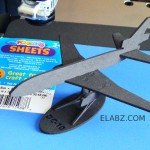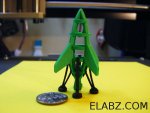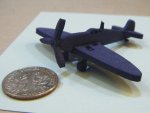- Joined
- Sep 25, 2009
- Messages
- 18
- Points
- 0
EDIT, Nov/2010:
This post has been receiving a modest amount of traffic from others looking to build laser cutters and unfortunately I think that it under-represents the difficulty of building a laser cutter.
While the pictures can attest to the fact that I can indeed cut fairly precise shapes out of thin paper, I consider this project a failure. This cutter used about 80mW of 404nm and could cut lined paper (very thin and cheap) at approximately 2" a minute which is essentially useless. I haven't been following recent diodes but even newer 440 lasers would have trouble with anything more than paper and would likely have problems cutting white paper of useful thickness.
I would never consider building another laser cutter with anything other than a CO2 laser (even when only cutting paper). Anything below that will always be a toy. Feel free to use a diode in your own projects but keep your expectations realistic.
If you have the technical expertise to wire up a stepper motor controller you should have no problems plugging a Chinese tube into the wall and the results will be well worth it.
Building a computer controlled laser cutter has been on my list of things to do for a while and I finally got around to it:

At the moment it is using a kenom 100mW PHR laser and is able to cut pretty well. Shown with some gears cut out of paper.

A poor quality picture of a spirograph pattern.

And the individual pieces. Most are significantly smaller than 1mm.
The cutter has some nice precision and cuts thin paper very well, but I'm looking to get some more umph from it. At the minimum I would like to be able to cut thick index card paper (~110lb) and would be happier if I could cut thin balsa wood and black plastic. The laser cutter has the advantage of being able to always maintain flawless focus and consistent and stable movement but I'm not sure what wavelength or power to get.
Size and price are both limiting factors here, a CO2 tube is out of the question since I can't easily mount it. A C-mount IR seems like a good option but I have read that they don't cut white paper very well, which is essentially the only material I will be cutting.
Blu-ray cuts white paper very well for its power output and will be easy to mount, but will cost a lot for its power.
Any suggestions? I am hoping to order a finished labby build from someone here once I figure out what I can afford. Any options need to be continuous use (Not sure how long the current PHR will last).
This post has been receiving a modest amount of traffic from others looking to build laser cutters and unfortunately I think that it under-represents the difficulty of building a laser cutter.
While the pictures can attest to the fact that I can indeed cut fairly precise shapes out of thin paper, I consider this project a failure. This cutter used about 80mW of 404nm and could cut lined paper (very thin and cheap) at approximately 2" a minute which is essentially useless. I haven't been following recent diodes but even newer 440 lasers would have trouble with anything more than paper and would likely have problems cutting white paper of useful thickness.
I would never consider building another laser cutter with anything other than a CO2 laser (even when only cutting paper). Anything below that will always be a toy. Feel free to use a diode in your own projects but keep your expectations realistic.
If you have the technical expertise to wire up a stepper motor controller you should have no problems plugging a Chinese tube into the wall and the results will be well worth it.
Building a computer controlled laser cutter has been on my list of things to do for a while and I finally got around to it:

At the moment it is using a kenom 100mW PHR laser and is able to cut pretty well. Shown with some gears cut out of paper.

A poor quality picture of a spirograph pattern.

And the individual pieces. Most are significantly smaller than 1mm.
The cutter has some nice precision and cuts thin paper very well, but I'm looking to get some more umph from it. At the minimum I would like to be able to cut thick index card paper (~110lb) and would be happier if I could cut thin balsa wood and black plastic. The laser cutter has the advantage of being able to always maintain flawless focus and consistent and stable movement but I'm not sure what wavelength or power to get.
Size and price are both limiting factors here, a CO2 tube is out of the question since I can't easily mount it. A C-mount IR seems like a good option but I have read that they don't cut white paper very well, which is essentially the only material I will be cutting.
Blu-ray cuts white paper very well for its power output and will be easy to mount, but will cost a lot for its power.
Any suggestions? I am hoping to order a finished labby build from someone here once I figure out what I can afford. Any options need to be continuous use (Not sure how long the current PHR will last).
Last edited:













